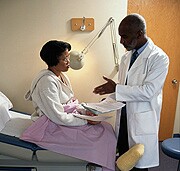
FRIDAY, Aug. 17 (HealthDay News) — Treatment for cervical disease does not necessarily increase a woman’s risk for preterm delivery, according to a new study.
The British researchers noted their findings are significant because about 40,000 women in England undergo cervical disease treatments every year. The findings also contradict previous studies that suggested women’s risk of giving birth prematurely would increase by about 5.6 percent.
“Considering all those treated previously who may be planning to have children, there may be half a million women in the U.K. who can relax now and not worry that they are at increased risk of a preterm birth,” study leader Peter Sasieni, professor of cancer epidemiology and biostatistics at the Wolfson Institute of Preventive Medicine, part of Queen Mary, University of London, said in a university news release.
Routine cervical screenings to detect cancer may be followed up with a colposcopy. During this procedure, a colposcope is used to provide a larger view of the cervix. These women also may have a biopsy in which a small sample of tissue is taken from their cervix. Women who have moderate to severe cervical changes may also have the abnormal tissue removed in a large loop excision using a small tool and electric current, known as an LLETZ.
Previous research cautioned that these treatments could increase women’s risk for giving birth to premature babies. To put this to the test, the researchers cross-referenced hospital obstetric records with the medical records of more than 44,000 women in England who had cervical tissue samples taken. They were able to identify more than 18,000 babies born to these women.
The researchers then examined the number of preterm births before and after colposcopy. They also compared women who had an LLETZ with those who only had a cervical biopsy. The investigators also compared preterm delivery rates among the study participants with overall preterm delivery rates in England.
The research revealed that 8.8 percent of the births among the women in the study were preterm, compared to 6.7 percent among the general population in England.
The women treated for cervical changes before pregnancy had about 1.4 more preterm births per 100 than those who had only a biopsy. The researchers noted, however, that the women who gave birth before undergoing a colposcopy also were more likely to give birth prematurely than those who had only a biopsy.
“Clearly treatment that has not occurred until after a birth cannot be causing preterm births,” Sasieni pointed out in the news release.
The researchers concluded that treatment for cervical abnormalities did not increase women’s risk for preterm delivery.
“Women should have more confidence in going for cervical screening and accepting the treatment offered to them,” Sasieni said. LLETZ “should still be seen as the treatment of choice. It would be premature to start using other treatments such as cryotherapy that may be less effective in treating cervical disease, in the hope that it would result in fewer preterm births.”
The study authors noted that quality-assurance issues in other countries may play a role in previous findings, which suggested there is a high risk of preterm birth associated with LLETZ. They added that more research is needed to investigate why the other studies found an increased risk and whether extensive cervical treatment or repeat treatments increase the risk of premature delivery.
Commenting on the findings, Julietta Patnick, director of the United Kingdom’s National Health Service Cancer Screening Programs, said, “[The findings] are an encouraging reflection of the high standards of our N.H.S. practitioners and our robust system of quality assurance.”
Patnick added, however, that, “previous studies have shown that treatments, including colposcopy and LLETZ, are linked to an increased risk of preterm deliveries, and it is important that we continue this project to provide firm evidence in this important area. Regular attendance at screening remains the top preventive measure against cervical cancer, and we would encourage all women to make the decision to attend when invited.”
The study was published online Aug. 17 in BMJ.
More information
The U.S. National Library of Medicine has more about cervix disorders.

